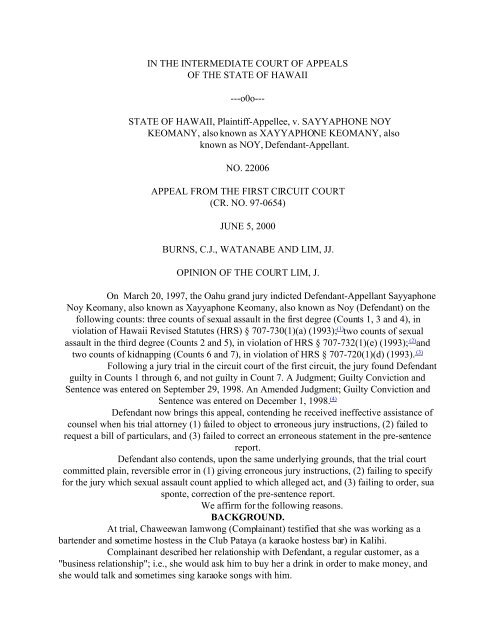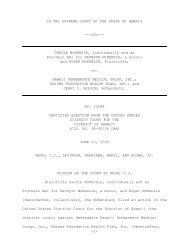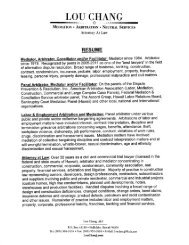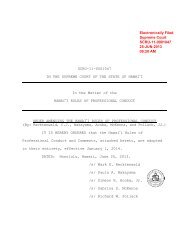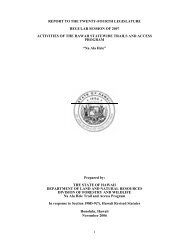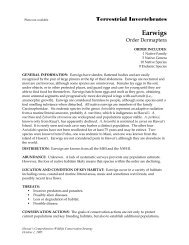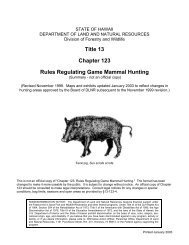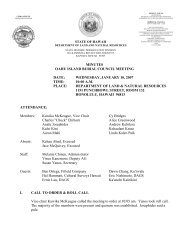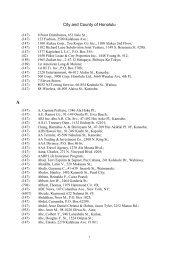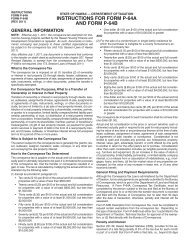standards of review. - State of Hawaii
standards of review. - State of Hawaii
standards of review. - State of Hawaii
Create successful ePaper yourself
Turn your PDF publications into a flip-book with our unique Google optimized e-Paper software.
IN THE INTERMEDIATE COURT OF APPEALS<br />
OF THE STATE OF HAWAII<br />
---o0o---<br />
STATE OF HAWAII, Plaintiff-Appellee, v. SAYYAPHONE NOY<br />
KEOMANY, also known as XAYYAPHONE KEOMANY, also<br />
known as NOY, Defendant-Appellant.<br />
NO. 22006<br />
APPEAL FROM THE FIRST CIRCUIT COURT<br />
(CR. NO. 97-0654)<br />
JUNE 5, 2000<br />
BURNS, C.J., WATANABE AND LIM, JJ.<br />
OPINION OF THE COURT LIM, J.<br />
On March 20, 1997, the Oahu grand jury indicted Defendant-Appellant Sayyaphone<br />
Noy Keomany, also known as Xayyaphone Keomany, also known as Noy (Defendant) on the<br />
following counts: three counts <strong>of</strong> sexual assault in the first degree (Counts 1, 3 and 4), in<br />
violation <strong>of</strong> <strong>Hawaii</strong> Revised Statutes (HRS) § 707-730(1)(a) (1993); (1) two counts <strong>of</strong> sexual<br />
assault in the third degree (Counts 2 and 5), in violation <strong>of</strong> HRS § 707-732(1)(e) (1993); (2) and<br />
two counts <strong>of</strong> kidnapping (Counts 6 and 7), in violation <strong>of</strong> HRS § 707-720(1)(d) (1993). (3)<br />
Following a jury trial in the circuit court <strong>of</strong> the first circuit, the jury found Defendant<br />
guilty in Counts 1 through 6, and not guilty in Count 7. A Judgment; Guilty Conviction and<br />
Sentence was entered on September 29, 1998. An Amended Judgment; Guilty Conviction and<br />
Sentence was entered on December 1, 1998. (4)<br />
Defendant now brings this appeal, contending he received ineffective assistance <strong>of</strong><br />
counsel when his trial attorney (1) failed to object to erroneous jury instructions, (2) failed to<br />
request a bill <strong>of</strong> particulars, and (3) failed to correct an erroneous statement in the pre-sentence<br />
report.<br />
Defendant also contends, upon the same underlying grounds, that the trial court<br />
committed plain, reversible error in (1) giving erroneous jury instructions, (2) failing to specify<br />
for the jury which sexual assault count applied to which alleged act, and (3) failing to order, sua<br />
sponte, correction <strong>of</strong> the pre-sentence report.<br />
We affirm for the following reasons.<br />
BACKGROUND.<br />
At trial, Chaweewan Iamwong (Complainant) testified that she was working as a<br />
bartender and sometime hostess in the Club Pataya (a karaoke hostess bar) in Kalihi.<br />
Complainant described her relationship with Defendant, a regular customer, as a<br />
"business relationship"; i.e., she would ask him to buy her a drink in order to make money, and<br />
she would talk and sometimes sing karaoke songs with him.
On the evening <strong>of</strong> the alleged <strong>of</strong>fenses, Defendant called Complainant at the bar and<br />
told her he was coming over. He arrived at the bar around 10:00 or 10:30 p.m. with his brother<br />
and a friend. Complainant sat with Defendant at his booth drinking cranberry juice with vodka,<br />
while he drank beer. After buying Complainant two drinks, Defendant left the bar.<br />
Half an hour later Defendant telephoned again. Complainant asked him to return to<br />
the bar, hoping to make more money. He returned alone around midnight. She sat with him, and<br />
he bought her another drink. When Defendant ran out <strong>of</strong> money, Complainant drove him to an<br />
automatic teller machine so he could make a withdrawal.<br />
Later that evening, Complainant agreed to give Defendant a ride home. Defendant,<br />
who implied to Complainant that he had bought a new house in the Kailua area, directed her to<br />
take the Pali Highway. At some point, he told Complainant to stop the car on the side <strong>of</strong> the road,<br />
and she complied. She was unfamiliar with the area.<br />
As Complainant said goodbye, Defendant tried to kiss her on the lips, but she turned<br />
away. He asked her why she turned away and when she did not reply, Defendant repeatedly<br />
punched her in the face, causing black eyes and a bleeding mouth. When she asked him why he<br />
was doing this to her, he ordered her to turn <strong>of</strong>f the engine and car lights and began to choke her.<br />
He then dragged her by her neck and shoulder out <strong>of</strong> the car to a shed on some<br />
farmland. In the shed, Complainant repeatedly asked Defendant why he was doing this to her,<br />
and pleaded with him not to kill her. Defendant said he wanted sex, and was upset that she was<br />
leaving to visit her family in Thailand.<br />
When Complainant screamed, Defendant ordered her not to scream and repeatedly<br />
punched and choked her. Complainant testified that she feared he would kill her unless she did<br />
whatever he wanted, so she removed her panties and told him to go ahead.<br />
Defendant removed all <strong>of</strong> his clothing and inserted his penis in Complainant's<br />
vagina. Defendant also placed his hand on her breast.<br />
After a couple <strong>of</strong> minutes, Complainant lied that she had to relieve herself outside.<br />
Once outside the shed, she started to run towards her car, but kept falling down in the mud.<br />
Defendant caught her and inserted his penis in her vagina again. When she complained that her<br />
back hurt on the ground and asked to return to the shed, he dragged her back to the shed.<br />
Complainant testified that she thought Defendant hit her again in the shed. She again<br />
pleaded with him not to kill her. Defendant again inserted his penis into Complainant's vagina<br />
and touched her breast.<br />
At one point during the assault, Complainant told Defendant she was a prostitute,<br />
hoping he might think she was "dirty" and stop.<br />
After Defendant ejaculated, Complainant drove him back across the Pali and<br />
dropped him <strong>of</strong>f in Kalihi, as he instructed. Complainant testified that as she was driving<br />
Defendant home, she drove at around eighty miles per hour, hoping the police would pull her<br />
over. She also testified that she invited Defendant to her house, thinking she could then call the<br />
police with the help <strong>of</strong> her live-in boyfriend and his friend, who were home at the time.<br />
Defendant initially agreed to go to Complainant's house, but changed his mind and told her to<br />
drop him <strong>of</strong>f in Kalihi.<br />
After dropping Defendant <strong>of</strong>f, Complainant immediately drove to the Kalihi police<br />
station and reported what had happened to her. She was later taken to the hospital by ambulance.<br />
Defendant testified that he had met Complainant one or two months before the night <strong>of</strong> the<br />
alleged assaults, and that she was a friend. He bought her drinks, they hugged; he thought she
liked him. She made him feel "good and happy."<br />
He testified that on the night in question, Complainant told him she was returning to<br />
Thailand and that she wanted to sleep with him before she left. When the bar closed, they left to<br />
go to Waimanalo to sleep together. Defendant testified that he neither forced nor restrained her.<br />
At the farm, they hugged and kissed, and walked hand-in-hand to the shed. As they<br />
did so, Complainant slipped and fell on the wet ground. They both laughed as Defendant helped<br />
her up. Inside the shed, they engaged in consensual sexual intercourse and he touched her breast.<br />
Defendant testified that Complainant hugged him and never said "no."<br />
After the sexual intercourse, Complainant told him that she was a prostitute and<br />
wanted money, but he had none. Defendant felt bad because he felt he meant nothing to her.<br />
Complainant repeatedly asked for Defendant's gold necklace. She then tried to take<br />
the necklace from around his neck, at which point Defendant pushed her, slapped her three or<br />
four times with his hand, and punched her in the face.<br />
Defendant then calmed down and apologized to her, and she drove him home to Kalihi.<br />
STANDARDS OF REVIEW.<br />
1. JURY INSTRUCTIONS.<br />
"When jury instructions or the omission there<strong>of</strong> are at issue on appeal, the standard <strong>of</strong><br />
<strong>review</strong> is whether, when read and considered as a whole, the instructions given are prejudicially<br />
insufficient, erroneous, inconsistent, or misleading."Arceo, 84 <strong>Hawaii</strong> at 11, 928 P.2d at 853<br />
(citations and internal quotation marks omitted); see also <strong>State</strong> v. Kupau, 76 <strong>Hawaii</strong> 387, 393,<br />
879 P.2d 492, 498 (1994). If the instructions requested by the parties are inaccurate or<br />
incomplete but are necessary "in order for the jury to 'have a clear and correct understanding <strong>of</strong><br />
what it is that they are to decide[,]'" then the trial court has the duty either to correct any defects<br />
or to fashion its own instructions. <strong>State</strong> v. Okumura, 78 <strong>Hawaii</strong> 383, 411, 894 P.2d 80, 108<br />
(1995) (citations omitted); accord <strong>State</strong> v. Kinnane, 79 <strong>Hawaii</strong> 46, 50, 897 P.2d 973, 977 (1995).<br />
Nevertheless, the "trial court is not required to instruct the jury in the exact words <strong>of</strong> the<br />
applicable statute but to present the jury with an understandable instruction that aids the jury in<br />
applying that law to the facts <strong>of</strong> the case." <strong>State</strong> v. Apao, 59 Haw. 625, 645, 586 P.2d 250, 263<br />
(1978), subsequent resolution, 66 Haw. 682, 693 P.2d 405 (1984). Erroneous instructions are<br />
presumptively harmful and are a ground for reversal unless it affirmatively appears from the<br />
record as a whole that the error was not prejudicial.<strong>State</strong> v. Robinson, 82 <strong>Hawaii</strong> 304, 310, 922<br />
P.2d 358, 364 (1996). If that standard is met, however, "the fact that a particular instruction or<br />
isolated paragraph may be objectionable, as inaccurate or misleading, will not constitute grounds<br />
for reversal."Pinero, 75 Haw. at 292, 859 P.2d at 1374. Whether a jury instruction accurately sets<br />
forth the relevant law is a question that this court <strong>review</strong>sde novo. Richardson v. Sport Shinko<br />
(Waikiki Corp.), 76 <strong>Hawaii</strong> 494, 504, 880 P.2d 169, 179 (1994).<strong>State</strong> v. Sawyer, 88 <strong>Hawaii</strong> 325,<br />
330, 966 P.2d 637, 642 (1998). [E]rror is not to be viewed in isolation and considered purely<br />
in the abstract. It must be examined in the light <strong>of</strong> the entire proceedings and given the effect<br />
which the whole record shows it to be entitled. In that context, the real question becomes whether<br />
there is a reasonable possibility that error might have contributed to conviction. If there is such a<br />
reasonable possibility in a criminal case, then the error is not harmless beyond a reasonable<br />
doubt, and the judgment <strong>of</strong> conviction on which it may have been based must be set aside.<strong>State</strong><br />
v. Cullen, 86 <strong>Hawaii</strong> 1, 8, 946 P.2d 955, 962 (1997) (internal quotation marks and citations
omitted).<br />
A lower court has substantial latitude in tailoring jury instructions provided they<br />
fairly and adequately cover the issues presented. United <strong>State</strong>s v. Soulard, 730 F.2d 1292, 1303<br />
(9 th Cir. 1984); accord<strong>State</strong> v. Nuetzel, 61 Haw. 531, 551, 606 P.2d 920, 932 (1980) (held [t]rial<br />
courts should not be restricted to merely repeating the terms <strong>of</strong> the statute); accord<strong>State</strong> v.<br />
Nakamura, 65 Haw. 74, 79, 648 P.2d 183, 187 (1982) (held instructions should not merely parrot<br />
the language <strong>of</strong> the statute).<br />
2. PLAIN ERROR.<br />
"We may recognize plain error when the error committed affects substantial rights <strong>of</strong><br />
the defendant." Cullen, 86 <strong>Hawaii</strong> at 8, 946 P.2d at 962 (internal quotation marks and citations omitted).<br />
3. INEFFECTIVE ASSISTANCE OF COUNSEL.<br />
In considering a defendant's claim <strong>of</strong> ineffective assistance <strong>of</strong> counsel, we employ<br />
the analysis adopted by the <strong>Hawaii</strong> Supreme Court: This court has long held that when an<br />
ineffective assistance <strong>of</strong> counsel claim is raised, the question is: "When viewed as a whole, was<br />
the assistance provided to the defendant within the range <strong>of</strong> competence demanded <strong>of</strong> attorneys<br />
in criminal cases?" <strong>State</strong> v. Edwards, 81 <strong>Hawaii</strong> 293, 300, 916 P.2d 703, 710 (1996). This court<br />
has also held thatthe defendant has the burden <strong>of</strong> establishing ineffective assistance <strong>of</strong> counsel<br />
and must meet the following two-part test: 1) that there were specific errors or omissions<br />
reflecting counsel's lack <strong>of</strong> skill, judgment, or diligence; and 2) that such errors or omissions<br />
resulted in either the withdrawal or substantial impairment <strong>of</strong> a potentially meritorious defense.<br />
Id. (quoting <strong>State</strong> v. Silva, 75 Haw. 419, 439-40, 864 P.2d 583, 593 (1993)). "Determining<br />
whether a defense is 'potentially meritorious' requires an evaluation <strong>of</strong> the possible, rather than<br />
the probable, effect <strong>of</strong> the defense on the decision maker. . . . Accordingly, no showing <strong>of</strong> 'actual'<br />
prejudice is required to prove ineffective assistance <strong>of</strong> counsel." Dan v. <strong>State</strong>, 76 <strong>Hawaii</strong> 423,<br />
427, 879 P.2d 528, 532 (1994).<br />
<strong>State</strong> v. Fukusaku, 85 <strong>Hawaii</strong> 462, 479-80, 946 P.2d 32, 49-50 (1997).<br />
DISCUSSION.<br />
1. ELEMENTS INSTRUCTIONS FOR SEXUAL ASSAULT IN THE FIRST DEGREE (Counts<br />
1, 3 & 4) AND THIRD DEGREE (Counts 2 & 5).<br />
Defendant contends that the trial court committed plain, reversible error in giving<br />
the following jury instructions, and that his trial counsel was ineffective in failing to object to<br />
their rendition:<br />
[Court's Instruction Nos. 27, 28 & 29]<br />
In Count [I, III and IV, respectively] <strong>of</strong> the Indictment, the [Defendant] is charged with the<br />
<strong>of</strong>fense <strong>of</strong> Sexual Assault in the First Degree.<br />
A person commits the <strong>of</strong>fense <strong>of</strong> Sexual Assault in the First Degree if he knowingly<br />
subjects another person to an act <strong>of</strong> sexual penetration by strong compulsion.<br />
There are four material elements to this <strong>of</strong>fense, each <strong>of</strong> which the prosecution must prove<br />
beyond a reasonable doubt. These four elements are:<br />
1. That on or about March 16, 1997, in the City and County <strong>of</strong> Honolulu, <strong>State</strong> Of <strong>Hawaii</strong>,<br />
the [Defendant] subjected [Complainant] to an act <strong>of</strong> sexual penetration by inserting his penis<br />
into her vagina; and<br />
2. That the Defendant did so by strong compulsion; and
3. That the Defendant did so knowingly; and<br />
4. That the Complainant did not consent.<br />
[Court's Instruction Nos. 32 & 33]<br />
In Count [II and V, respectively] <strong>of</strong> the Indictment, the [Defendant] is charged with the<br />
<strong>of</strong>fense <strong>of</strong> Sexual Assault in the Third Degree.<br />
A person commits the <strong>of</strong>fense <strong>of</strong> Sexual Assault in the Third Degree if he knowingly, by<br />
strong compulsion, has sexual contact with another person, who is not his spouse, or causes such<br />
person to have sexual contact with the actor.<br />
There are five material elements to this <strong>of</strong>fense, each <strong>of</strong> which the prosecution must prove<br />
beyond a reasonable doubt. These five elements are:<br />
1. That on or about March 16, 1997, in the City and County <strong>of</strong> Honolulu, <strong>State</strong> <strong>of</strong> <strong>Hawaii</strong>,<br />
the [Defendant] had sexual contact with [Complainant] by placing his hand on her breast; and<br />
2. That the Defendant did so by strong compulsion; and<br />
3. That the Defendant did so knowingly; and<br />
4. That at the time <strong>of</strong> the <strong>of</strong>fense [Complainant] was not married to the Defendant; and<br />
5. That the Complainant did not consent. Defendant maintains that the<br />
foregoing instructions were erroneous. Specifically, Defendant contends they were prejudicially<br />
insufficient because they inadequately informed the jury that the specified state <strong>of</strong> mind,<br />
"knowingly," applied to each element <strong>of</strong> each <strong>of</strong>fense, pursuant to HRS § 702-207 (1993). HRS §<br />
702-207 provides:When the definition <strong>of</strong> an <strong>of</strong>fense specifies the state <strong>of</strong> mind sufficient for the<br />
commission <strong>of</strong> that <strong>of</strong>fense, without distinguishing among the elements there<strong>of</strong>, the specified<br />
state <strong>of</strong> mind shall apply to all elements <strong>of</strong> the <strong>of</strong>fense, unless a contrary purpose plainly<br />
appears.In addition, HRS §701-114 (1993) provides, in pertinent part, that:[N]o person may be<br />
convicted <strong>of</strong> an <strong>of</strong>fense unless the following are proved beyond a reasonable doubt:(a) Each<br />
element <strong>of</strong> the <strong>of</strong>fense;<br />
(b) The state <strong>of</strong> mind required to establish each element <strong>of</strong> the <strong>of</strong>fense[.] Defendant<br />
explains that the listing <strong>of</strong> certain elementsafterthe specified state <strong>of</strong> mind left those elements<br />
textually unmodified by the applicable state <strong>of</strong> mind, and thus erroneously implied to the jury<br />
that the state <strong>of</strong> mind did not apply to those elements.<br />
As is evident from the quoted instructions, supra, in the elements instructions for the<br />
three counts <strong>of</strong> sexual assault in the first degree and the two counts <strong>of</strong> sexual assault in the third<br />
degree, the lack <strong>of</strong> consent element was stated after the applicable state <strong>of</strong> mind. In addition, in<br />
the elements instructions for the two counts <strong>of</strong> sexual assault in the third degree, the absence <strong>of</strong><br />
marriage element was also subsequently stated.<br />
Defendant did not object to the instructions at trial and therefore alleges plain error<br />
on appeal. An appellate court may recognize plain error when the error committed affects<br />
substantial rights <strong>of</strong> the defendant. Cullen, 86 <strong>Hawaii</strong> at 8, 946 P.2d at 962.<br />
Defendant's arguments are, however, without merit in that they do not show<br />
predicate error.<br />
Due process prohibits conviction <strong>of</strong> a defendant unless the jury finds that all facts<br />
constituting the <strong>of</strong>fense have been proved beyond a reasonable doubt. <strong>State</strong> v. Iosefa, 77 <strong>Hawaii</strong><br />
177, 182, 880 P.2d 1224, 1229 (App. 1994). HRS § 702-205 (1993) defines the elements <strong>of</strong> an<br />
<strong>of</strong>fense as follows: The elements <strong>of</strong> an <strong>of</strong>fense are such (1) conduct, (2) attendant<br />
circumstances, and (3) results <strong>of</strong> conduct, as:(a) Are specified by the definition <strong>of</strong> the <strong>of</strong>fense, and
(b) Negative a defense (other than a defense based on the statute <strong>of</strong> limitations, lack <strong>of</strong> venue, or<br />
lack <strong>of</strong> jurisdiction). HRS § 707-730(1)(a) provides that a person commits the<br />
<strong>of</strong>fense <strong>of</strong> sexual assault in the first degree if "[t]he person knowingly subjects another person to<br />
an act <strong>of</strong> sexual penetration by strong compulsion[.]"<br />
Hence, as stated by the trial court, the elements <strong>of</strong> sexual assault in the first degree to<br />
which the state <strong>of</strong> mind applied, pursuant to HRS §§702-205 and 702-207, are that Defendant (1)<br />
placed his penis (conduct) (2) in Complainant's vagina (result <strong>of</strong> conduct) (3) by strong<br />
compulsion and therefore, as discussed infra, without her consent (attendant circumstance).<br />
HRS § 707-732(1)(e) provides that a person commits the <strong>of</strong>fense <strong>of</strong> sexual assault in<br />
the third degree if "[t]he person knowingly, by strong compulsion, has sexual contact with<br />
another person or causes another person to have sexual contact with the actor[.]"<br />
Accordingly, as stated by the trial court, the elements <strong>of</strong> sexual assault in the third<br />
degree to which the state <strong>of</strong> mind applied, pursuant to HRS §§702-205 and 702-207, are that<br />
Defendant (1) placed his hand (conduct) (2) on Complainant's breast (result <strong>of</strong> conduct) (3) by<br />
strong compulsion and therefore without her consent (attendant circumstance) and, as implied by<br />
the term "sexual contact" discussed infra, (4) while not married to her (attendant circumstance).<br />
Defendant's argument is, therefore, that the state <strong>of</strong> mind "knowingly," by virtue <strong>of</strong><br />
its placement in the elements instructions, failed to modify the attendant circumstances <strong>of</strong> lack <strong>of</strong><br />
consent and, where applicable, absence <strong>of</strong> marriage, as required by HRS §§702-207 and 701-114.<br />
The definition <strong>of</strong> "knowingly" depends, however, upon the kind <strong>of</strong> element that is<br />
being modified. HRS § 702-206(2) (1993) defines the state <strong>of</strong> mind "knowingly" as follows:(2)<br />
"Knowingly."<br />
(a) A person acts knowingly with respect to his conduct when he is aware that his conduct is <strong>of</strong><br />
that nature.<br />
(b) A person acts knowingly with respect to attendant circumstances when he is aware that such<br />
circumstances exist.<br />
(c) A person acts knowingly with respect to a result <strong>of</strong> his conduct when he is aware that it is<br />
practically certain that his conduct will cause such a result. In other words, Defendant<br />
acted knowingly with respect to the relevant attendant circumstances if, with respect to the<br />
sexual assault charges <strong>of</strong> both degrees, he was aware Complainant did not consent, and also if,<br />
with respect to the sexual assault in the third degree charges, he was aware he was not married to<br />
the Complainant.<br />
Although the attendant circumstances <strong>of</strong> lack <strong>of</strong> consent and absence <strong>of</strong> marriage<br />
were elements listed after the specification <strong>of</strong> the applicable state <strong>of</strong> mind, and hence were<br />
arguably left textually unmodified by it in the elements instructions, that fact alone does not<br />
render the jury instructions erroneous.<br />
"When jury instructions or the omission there<strong>of</strong> are at issue on appeal, the standard<br />
<strong>of</strong> <strong>review</strong> is whether, when read and considered as a whole, the instructions given are<br />
prejudicially insufficient, erroneous, inconsistent, or misleading." Sawyer, 88 <strong>Hawaii</strong> at 330, 966<br />
P.2d at 642 (internal quotation marks and citations omitted)(emphasis added).<br />
Reading and considering the jury instructions as a whole, we first observe that the<br />
trial court's Instruction No. 16 did instruct the jury, verbatim from HRS § 702-206(2), that:<br />
A person acts knowingly with respect to his conduct when he is aware that his conduct is <strong>of</strong> that<br />
nature.<br />
A person acts knowingly with respect to attendant circumstances when he is aware that
such circumstances exist.<br />
A person acts knowingly with respect to a result <strong>of</strong> his conduct when he is aware that it is<br />
practically certain that his conduct will cause such a result.(Emphasis added).<br />
In addition, the trial court instructed the jury on the defense <strong>of</strong> consent in Instruction<br />
Nos. 24 and 40, as follows:<br />
Court's Instruction No. 24<br />
In any prosecution, the complaining witness' consent to the conduct alleged or to the result<br />
there<strong>of</strong>, is a defense if the consent negatives an element <strong>of</strong> the <strong>of</strong>fense or precludes the infliction<br />
<strong>of</strong> the harm or evil sought to be prevented by the law defining the <strong>of</strong>fense.<br />
Consent is not a defense if it is induced by force, duress, or deception. As to all counts, the<br />
burden is upon the prosecution to prove beyond a reasonable doubt that the complaining witness<br />
did not consent to the conduct alleged or the result there<strong>of</strong>. If the prosecution fails to meet its<br />
burden, then you must find the defendant not guilty.<br />
[Court's Instruction No. 40]<br />
Consent can be either explicit or implicit. Express consent is positive, direct, unequivocal,<br />
requiring no inference or implication to supply its meaning.<br />
Implicit consent is consent that is manifested by signs, actions, or facts, or by inaction or<br />
silence, which raise a presumption that consent had been given. Given these<br />
supplemental instructions, the jury instructions, read and considered as a whole, ensured that the<br />
order <strong>of</strong> the elements instructions did not mislead the jury into relieving the <strong>State</strong> <strong>of</strong> its burden <strong>of</strong><br />
proving that the Defendant was aware <strong>of</strong> the elemental attendant circumstances.<br />
Instruction No. 16 provided a definition <strong>of</strong> the state <strong>of</strong> mind "knowingly," which<br />
applied to each generic element <strong>of</strong> a criminal <strong>of</strong>fense; i.e., conduct, attendant circumstances and<br />
result <strong>of</strong> conduct. Hence even if we assume that the elements instructions failed to apply the state<br />
<strong>of</strong> mind to the specific attendant circumstances <strong>of</strong> lack <strong>of</strong> consent and absence <strong>of</strong> marriage,<br />
Instruction No. 16 nevertheless defined "knowingly," with respect to attendant circumstances, as<br />
the state <strong>of</strong> mind <strong>of</strong> the Defendant in which he was indeed aware <strong>of</strong> the attendant circumstances.<br />
Moreover, with respect to the attendant circumstance <strong>of</strong> lack <strong>of</strong> consent, the<br />
instructions defining "consent," particularly Instruction No. 40, contained in and <strong>of</strong> themselves<br />
the knowledge element because they required that consent be explicitly or implicitly<br />
communicated to the Defendant.<br />
This means that if the <strong>State</strong> failed to disprove Complainant's consent, then that<br />
consent, by definition, was explicitly or implicitly communicated to the Defendant, such that he<br />
must have had the requisite awareness <strong>of</strong> it. By the same token, if the <strong>State</strong> proved Complainant's<br />
lack <strong>of</strong> consent, there was no communication <strong>of</strong> that consent in any way and the Defendant was<br />
therefore aware <strong>of</strong> its absence.<br />
Consent, by definition, subsumes awareness by a defendant and can stand alone with<br />
respect to the applicable state <strong>of</strong> mind. Though the modifier "did so knowingly" was not<br />
textually applied to the element <strong>of</strong> lack <strong>of</strong> consent, the desideratum <strong>of</strong> applying that state <strong>of</strong> mind<br />
to that element was nonetheless communicated to the jury.<br />
As a final point with respect to the attendant circumstance <strong>of</strong> lack <strong>of</strong> consent, we<br />
observe that the elements instructions required a finding that the Defendant acted by "strong<br />
compulsion."<br />
We also observe that, unlike the other attendant circumstances <strong>of</strong> lack <strong>of</strong> consent and<br />
absence <strong>of</strong> marriage, this element was textually modified by the applicable state <strong>of</strong> mind,
"knowingly."<br />
The trial court's Instruction No. 31 defined this element, verbatim from the pertinent<br />
provisions <strong>of</strong> HRS §707-700 (1993), as follows:<br />
[Court's Instruction No. 31]<br />
"Strong compulsion" means the use <strong>of</strong> or attempt to use one or more <strong>of</strong> the following to<br />
overcome a person:<br />
1. A threat, express or implied, that places a person in fear <strong>of</strong> bodily injury to the individual<br />
or another person, or in fear that the person or another person will be kidnapped; or<br />
2. Physical force. By their very definitions, strong compulsion and consent are<br />
mutually exclusive, for the consent instructions stated that "[c]onsent is not a defense if it is<br />
induced by force, duress, or deception." Hence a jury finding <strong>of</strong> strong compulsion precludes a<br />
concomitant finding <strong>of</strong> consent. See<strong>State</strong> v. Lira, 70 Haw. 23, 27-31, 759 P.2d 869, 872-74<br />
(1988); <strong>State</strong> v. Suka, 70 Haw. 472, 478-79, 777 P.2d 240, 243-44 (1989). (5)<br />
Under this formulation, if the jury found that Defendant acted by strong compulsion,<br />
it necessarily also found that Complainant did not consent. If she did not consent, then by<br />
definition consent was not communicated either implicitly or explicitly, and thus Defendant was<br />
aware it was absent.<br />
If the jury found, furthermore and pursuant to the elements instructions, that<br />
Defendant knowingly acted by strong compulsion, it necessarily also found that Defendant was<br />
aware Complainant did not consent.<br />
Defendant cites Suka,supra, to support his subsidiary argument that separating lack<br />
<strong>of</strong> consent from strong compulsion in the elements instructions conveyed the misconception that<br />
they are separate and distinct concepts. Defendant incorrectly applies Sukato this case.<br />
In Suka, the trial court instructed the jury on "forcible compulsion" but did not<br />
instruct the jury on the defense <strong>of</strong> consent. The <strong>Hawaii</strong> Supreme Court found that the definition<br />
<strong>of</strong> "forcible compulsion" given to the jury was worded in a way that "does not make the mutual<br />
exclusion <strong>of</strong> consent and forcible compulsion obvious. Only the giving <strong>of</strong> a consent instruction<br />
will ensure that the defense <strong>of</strong> consent is not compromised." (6) Id.at 478, 777 P.2d at 244.<br />
The jury in this case was, however, given a consent instruction, thereby eliminating<br />
the potential for confusion.<br />
Finally, with respect to the circumstance <strong>of</strong> absence <strong>of</strong> marriage attendant to the two<br />
sexual assault in the third degree charges, we observe that the trial court instructed the jury<br />
that: A person commits the <strong>of</strong>fense <strong>of</strong> Sexual Assault in the Third Degree if he knowingly,<br />
by strong compulsion, has sexual contactwith another person, who is not his spouse, or causes<br />
such person to have sexual contact with the actor.<br />
. . . .<br />
"Sexual contact" means any touching <strong>of</strong> the sexual or other intimate parts <strong>of</strong> a person not<br />
married to the actor, or <strong>of</strong> the sexual or other intimate parts <strong>of</strong> the actor by the person, whether<br />
directly or through the clothing or other material intended to cover the sexual or other intimate<br />
parts."HRS §§707-732(1)(e) & 707-700 (emphases added).<br />
Because the enumerated elements <strong>of</strong> sexual assault in the third degree did apply the<br />
state <strong>of</strong> mind "knowingly" to the element <strong>of</strong> sexual contact, and because "sexual contact" by<br />
definition subsumes the attendant circumstance <strong>of</strong> absence <strong>of</strong> marriage, the jury was adequately<br />
instructed to apply the requisite state <strong>of</strong> mind to that attendant circumstance. Too, the<br />
instructions expressly informed the jury that a person commits the <strong>of</strong>fense <strong>of</strong> sexual assault in the
third degree if he knowingly has sexual contact with a person "who is not his spouse."<br />
To summarize with respect to the elements instructions for the sexual assault counts,<br />
the placement <strong>of</strong> the elemental attendant circumstances after the state <strong>of</strong> mind in the enumerated<br />
elements was not error. (7) When read and considered as a whole, the instructions adequately<br />
informed the jury <strong>of</strong> the prosecution's burden to prove that Complainant did not consent to the<br />
acts alleged and was not married to the Defendant at the time, and that Defendant was aware <strong>of</strong><br />
both circumstances when he acted. (8)<br />
While the jury instructions on the sexual assaults were by no means exemplary,<br />
Defendant has failed to show that as a whole they were prejudicially insufficient, erroneous,<br />
inconsistent or misleading. There being no error, defendant's contention that the trial court<br />
committed plain error in rendering the jury instructions must fail, as must his argument that his<br />
trial counsel was ineffective in failing to object to the instructions.<br />
2. ELEMENTS INSTRUCTION FOR KIDNAPPING (Count 6).<br />
Defendant asserts the same arguments with respect to the trial court's Instruction No.<br />
36, on the material elements <strong>of</strong> the kidnapping charge, which read as follows:<br />
[Court's Instruction No. 36]<br />
In Count VI <strong>of</strong> the Indictment, the [Defendant] is charged with the <strong>of</strong>fense <strong>of</strong> Kidnapping.<br />
A person commits the <strong>of</strong>fense <strong>of</strong> Kidnapping if he intentionally or knowingly restrains<br />
another person with intent to inflict bodily injury upon that person or subject that person to a<br />
sexual <strong>of</strong>fense.<br />
There are four material elements <strong>of</strong> the <strong>of</strong>fense <strong>of</strong> Kidnapping, each <strong>of</strong> which the<br />
prosecution must prove beyond a reasonable doubt.<br />
These four elements are:<br />
1. That on or about March 16, 1997, in the City and County <strong>of</strong> Honolulu, <strong>State</strong> <strong>of</strong> <strong>Hawaii</strong>,<br />
the [Defendant] restrained [Complainant]; and<br />
2. That the Defendant did so intentionally or knowingly; and<br />
3. That the Defendant did so with intent to inflict bodily injury upon [Complainant] or to<br />
subject her to a sexual <strong>of</strong>fense; and<br />
4. That the Complainant did not consent. Defendant again contends the<br />
instructions failed to adequately inform the jury that the specified state <strong>of</strong> mind, in this instance<br />
"intentionally or knowingly," applied to each and every element <strong>of</strong> the <strong>of</strong>fense; specifically, the<br />
element <strong>of</strong> lack <strong>of</strong> consent enumerated after the specified state <strong>of</strong> mind.<br />
When we read and consider the jury instructions as a whole, in particular the<br />
"intentionally" (instruction 15), "knowingly" (instruction 16) and consent (instructions 24 and<br />
40) instructions, we again and for much the same reasons conclude that the instructions were not<br />
erroneous.<br />
Instruction No. 15 defined the state <strong>of</strong> mind "intentionally," verbatim from<br />
HRS §702-206(1), as follows:<br />
Court's Instruction No. 15<br />
A person acts intentionally with respect to his conduct when it is his conscious object to<br />
engage in such conduct.<br />
A person acts intentionally with respect to attendant circumstances when he is aware <strong>of</strong> the<br />
existence <strong>of</strong> such circumstances or believes or hopes that they exist.<br />
A person acts intentionally with respect to a result <strong>of</strong> his conduct when it is his conscious<br />
object to cause such a result.(Emphasis added).
This instruction, in conjunction with Instruction No. 16, informed the jury that the<br />
specified state <strong>of</strong> mind, "intentionally or knowingly," means that the Defendant had to be aware<br />
<strong>of</strong> the attendant circumstances, including lack <strong>of</strong> consent, as explained supra.<br />
In addition, the instructions (24 and 40) on consent explained the <strong>State</strong>'s burden to<br />
prove that the Complainant did not consent to the conduct alleged or the result there<strong>of</strong>. As also<br />
previously discussed, the very definition <strong>of</strong> consent married the lack <strong>of</strong> consent to the<br />
Defendant's awareness <strong>of</strong> it.<br />
Finally, we observe that the elements instructions on the kidnapping charge required<br />
a finding that Defendant "restrained" the Complainant. We also observe they textually modified<br />
this element by the applicable state <strong>of</strong> mind, "intentionally or knowingly."<br />
The trial court's Instruction No. 38 defined this element as follows:<br />
[Court's Instruction No. 38]<br />
"Restrain" means to restrict a person's movement in such a manner as to interfere<br />
substantially with his liberty by means <strong>of</strong> force, threat, or deception.Instruction No. 38 was taken<br />
verbatim from the pertinent provisions <strong>of</strong> HRS § 707-700 that define "restrain."<br />
By their very definitions, restraint and consent are mutually exclusive, for the<br />
consent instructions stated that "[c]onsent is not a defense if it is induced by force, duress, or<br />
deception." As we reasoned previously with respect to the antithetical relationship between<br />
strong compulsion and consent, a jury finding <strong>of</strong> restraint extrudes a finding <strong>of</strong> consent. Cf.Lira,<br />
70 Haw. at 27-31, 759 P.2d at 872-74; Suka, 70 Haw. at 478-79, 777 P.2d at 243-44; People v.<br />
Roberts, 537 N.E.2d 1080, 1082-83 (Ill. App. Ct. 1989).<br />
It follows that if the jury found that Defendant restrained the Complainant, it<br />
necessarily also found that she did not consent. If she did not consent, then by definition consent<br />
was not communicated either implicitly or explicitly to the Defendant and he wasipso facto<br />
aware <strong>of</strong> its absence. If the jury found, furthermore and pursuant to the elements instructions, that<br />
Defendant intentionally or knowingly restrained Complainant, it necessarily also found that he<br />
knew she did not consent.<br />
Here again, we recognize that the jury instructions were by no means exemplary.<br />
Nonetheless, in this instance Defendant has again failed to show that the jury instructions as a<br />
whole were prejudicially insufficient, erroneous, inconsistent or misleading. There being no<br />
error, Defendant's contention that the trial court committed plain error in issuing the elements<br />
instructions must also fail, along with his argument that his trial counsel was ineffective in<br />
failing to object to the instructions.<br />
3. JURY INSTRUCTIONS ON SEPARATE AND DISTINCT INTENTS.<br />
Defendant also challenges the trial court's Instruction No. 25, which read as follows:<br />
Court's Instruction No. 25<br />
Whether a course <strong>of</strong> conduct gives rise to more than one crime depends in part on the intent<br />
and objective <strong>of</strong> the defendant. The test to determine whether the defendant intended to commit<br />
more than one <strong>of</strong>fense is whether the evidence discloses one general intent or discloses separate<br />
and distinct intents. Where there is one intention, one general impulse, and one plan, there is but<br />
one <strong>of</strong>fense.<br />
The burden is on the prosecution to prove beyond a reasonable doubt that the defendant had<br />
separate and distinct intents to commit separate and distinct <strong>of</strong>fenses.<br />
Thus, if you find the defendant guilty <strong>of</strong> Count I [sexual assault in the first degree], you<br />
must not find him guilty <strong>of</strong> Count II [sexual assault in the third degree] unless you find that the
prosecution has proven beyond a reasonable doubt that the defendant had a separate and distinct<br />
intent to commit Count II.<br />
Also, if you find the defendant guilty <strong>of</strong> Count IV [sexual assault in the first degree], you<br />
must not find the defendant guilty <strong>of</strong> Count V [sexual assault in the third degree] unless the<br />
prosecution has proven beyond a reasonable doubt that defendant had a distinct and separate<br />
intent to commit Count V.<br />
Finally, you may find the defendant guilty <strong>of</strong> both [kidnapping] Counts VI and VII only if<br />
you find that the prosecution has proven beyond a reasonable doubt that the defendant had<br />
separate and distinct intents to commit both Counts VI and VII. Defendant contends<br />
Instruction No. 25 was prejudicially misleading. Defendant argues that[t]his instruction is<br />
erroneous for two reasons. First, the instruction told the jury that to convict [Defendant] <strong>of</strong> both<br />
Sexual Assault in the First Degree and Sexual Assault in the Third Degree it had to find separate<br />
and distinct intents, but then defined that intent as the same for both degrees <strong>of</strong> sexual assault<br />
(i.e., "knowingly"). For all the jury knew, if it found that the intent for both degrees <strong>of</strong> sexual<br />
assault was "knowingly," that in and <strong>of</strong> itself was sufficient to convict [Defendant] <strong>of</strong> both<br />
degrees <strong>of</strong> sexual assault. Second, the instruction failed to identify to the jury<br />
the separateanddistinctactswhich the jury had to find to convict for each Sexual Assault in the<br />
First Degree count and each Sexual Assault in the Third Degree count. Trial defense counsel's<br />
failure to request (1) a bill <strong>of</strong> particulars for the sexual assault counts, (2) instructions informing<br />
the jury that the separate and distinct intents necessary to convict <strong>of</strong> both degrees <strong>of</strong> sexual<br />
assault did not mean "knowingly" for one degree and a different intent (such as "intentionally")<br />
for the other degree, and (3) instructions setting forth the separate and distinct acts the jury would<br />
have to find to convict [Defendant] <strong>of</strong> each Sexual Assault in the First degree count and each<br />
Sexual Assault in the Third Degree count constitute ineffective assistance <strong>of</strong> counsel. The trial<br />
court's failure to correctly instruct the jury on these points constituted plain reversible<br />
error.(Footnote omitted).<br />
Defendant's arguments founder for the following reasons.<br />
First, his assertion that the instruction would preoccupy the jury with the mens rea<br />
element to the exclusion <strong>of</strong> the other elements <strong>of</strong> the <strong>of</strong>fenses is, in our view, a speculative reach<br />
too far to seriously suggest error. The same goes for his contention that the instruction's reference<br />
to separate and distinct intents would send the jury on a futile and erroneous search for a state <strong>of</strong><br />
mind other than the single one applicable ("knowingly").<br />
Regarding Defendant's general plaint that the instruction was confusing, the record<br />
reveals that Counts 1, 3, and 4 (sexual assault in the first degree), and Counts 2 and 5 (sexual<br />
assault in the third degree), were each supported by evidence <strong>of</strong> an act separate and distinct from<br />
the acts charged in the other counts. See<strong>State</strong> v. Horswill, 75 Haw. 152, 161-63, 857 P.2d 579,<br />
584-85 (1993). (9)<br />
The <strong>Hawaii</strong> Supreme Court has held that sexual assault in the first and third degrees<br />
are not continuing <strong>of</strong>fenses; thus each separate and distinct act in violation <strong>of</strong> the governing<br />
statutes constitutes a separate <strong>of</strong>fense. Arceo, 84 <strong>Hawaii</strong> at 21-23, 928 P.2d at 863-64. Defendant<br />
was therefore properly charged under separate counts for the separate <strong>of</strong>fenses, and the trial court<br />
was required to instruct the jury on each <strong>of</strong> the separate counts.<br />
The court's instructions, quoted in preceding sections <strong>of</strong> this opinion, enumerated the<br />
elements <strong>of</strong> the sexual assault <strong>of</strong>fenses. The instructions on sexual assault in the first degree<br />
clearly and explicitly described the act <strong>of</strong> sexual penetration as the insertion <strong>of</strong> Defendant's penis
into Complainant's vagina. The instructions on sexual assault in the third degree also<br />
unambiguously described the act <strong>of</strong> sexual contact, as the placing <strong>of</strong> Defendant's hand on<br />
Complainant's breast.<br />
Instruction No. 25 further informed the jury that in order to find Defendant guilty<br />
under a count, he must have had a separate and distinct intent unique to that count. The<br />
instruction served to protect the rights <strong>of</strong> the Defendant by ensuring that he was not convicted for<br />
multiple <strong>of</strong>fenses if he had the intent to commit only one <strong>of</strong>fense. See, e.g., <strong>State</strong> v. Hoey, 77<br />
<strong>Hawaii</strong> 17, 37-39, 881 P.2d 504, 524-26 (1994).<br />
Defendant's arguments regarding the clarity <strong>of</strong> Instruction No. 25 might be well<br />
taken if the instruction had been given in isolation. It was given, however, as part <strong>of</strong> an entire set<br />
<strong>of</strong> instructions. Read and considered as a whole, they were clear and understandable, and not<br />
erroneous. At any rate, any jury confusion regarding the requirement <strong>of</strong> separate and distinct<br />
intents could only have inured to Defendant's benefit.<br />
As for the two kidnapping charges, the prosecuting attorney conceded at trial that the<br />
kidnapping <strong>of</strong>fense in Count 7 merged with that in Count 6. Accordingly, the jury found<br />
Defendant not guilty <strong>of</strong> Count 7. Hence even if there was error in this particular respect,<br />
Defendant was not prejudiced.<br />
Defendant also claims that a bill <strong>of</strong> particulars was necessary to show which count<br />
applied to which act. Defendant fails, however, to show why a bill <strong>of</strong> particulars was apropos.<br />
A bill <strong>of</strong> particulars is "designed 'to enable the defendant to prepare for trial and<br />
prevent surprise[.]'" <strong>State</strong> v. Reed, 77 <strong>Hawaii</strong> 72, 78, 881 P.2d 1218, 1224 (1994) (quoting<strong>State</strong><br />
v. Harper, 1 Haw. App. 481, 486, 620 P.2d 1087, 1091 (1980)) (citation omitted). Defendant<br />
does not assert that he failed to receive adequate notice <strong>of</strong> the specific charges. He does not claim<br />
prejudicial surprise or an inability to prepare to meet the charges by virtue <strong>of</strong> insufficient<br />
notice. Seeid.<br />
There was, moreover, no need to specify, in advance <strong>of</strong> trial or in the jury<br />
instructions, the separate and distinct act in question in each sexual assault count. The pretrial<br />
record and the evidence at trial each clearly and unambiguously shows that there were precisely<br />
three possible separate and distinct acts <strong>of</strong> sexual penetration for the three sexual assault in the<br />
first degree counts, and precisely two possible separate and distinct acts <strong>of</strong> sexual contact for the<br />
two sexual assault in the third degree counts. SeeHorswill, 75 Haw. at 156-59, 857 P.2d at<br />
582-83 (where the trial court instructed the jury on two separate counts and the evidence showed<br />
two separate acts clearly accounting for the two separate counts, further specification in the jury<br />
instructions was not required).<br />
This case is distinguishable from Arceo, supra, in which there were more discrete<br />
acts than counts. By the same token, any argument that the trial court should have given a<br />
unanimity instruction must fail. See<strong>State</strong> <strong>of</strong> <strong>Hawaii</strong> v. Justin Valentine, slip op. at 16-18 (Haw.<br />
filed May 2, 2000).<br />
The trial court's Instruction No. 25, when read and considered in conjunction with<br />
the jury instructions as a whole, was not prejudicially insufficient, erroneous, inconsistent or<br />
misleading. It cannot, therefore, support a point <strong>of</strong> plain error or <strong>of</strong> ineffective assistance <strong>of</strong> counsel.<br />
4. INCORRECT NOTATION IN THE PRE-SENTENCE REPORT.<br />
For his last point on appeal, Defendant contends that the Pre-sentence Diagnosis and<br />
Report (aka PSI -- pre-sentence investigation), which identified the kidnapping conviction in
Count 6 as a conviction <strong>of</strong> a Class A felony, should have been amended to reflect that Defendant<br />
was instead convicted <strong>of</strong> kidnapping as a Class B felony.<br />
Defendant argues that defense counsel's failure to request appropriate amendment <strong>of</strong><br />
the PSI and the trial court's failure to amend the PSI sua sponte amounted to ineffective<br />
assistance <strong>of</strong> counsel and plain error, respectively.<br />
Defendant fears that the inaccurate notation will adversely affect his custodial<br />
classification, programming, transfer and release, if it is relied upon by the Division <strong>of</strong><br />
Corrections and the <strong>Hawaii</strong> Paroling Authority.<br />
At the sentencing hearing held on September 29, 1998, however, the trial judge<br />
orally clarified the record, noting that Defendant was indeed found guilty <strong>of</strong> kidnapping as a<br />
Class B felony. Moreover, Defendant or his attorney can appear at all subsequent hearings and<br />
submit whatever clarifying information is needed.<br />
Defendant fails to show how the oversight affected his substantial rights, or how it<br />
may have resulted in substantial impairment <strong>of</strong> a potentially meritorious defense, so as to<br />
constitute plain error or ineffective assistance <strong>of</strong> counsel. To the extent that Defendant argues on<br />
this basis for vacating the judgment, his argument lacks merit.<br />
However, as the <strong>Hawaii</strong> Supreme Court has implied that the trial court may amend a<br />
PSI, <strong>State</strong> v. Nobriga, 56 Haw. 75, 80, 527 P.2d 1269, 1272-73 (1974), to avoid future<br />
misunderstandings the PSI should be corrected to reflect that Defendant was convicted <strong>of</strong><br />
kidnapping as a Class B felony. Seealso<strong>State</strong> v. Lessary, 83 <strong>Hawaii</strong> 280, 284-85, 925 P.2d 1104,<br />
1108-09 (App. 1996).<br />
CONCLUSION.<br />
In light <strong>of</strong> the foregoing, the December 1, 1998 Amended Judgment; Guilty<br />
Conviction and Sentence is affirmed, but the case is remanded to the trial court for the sole<br />
purpose <strong>of</strong><br />
correction <strong>of</strong> the PSI to accurately reflect that Defendant was convicted under Count 6 <strong>of</strong><br />
kidnapping as a Class B felony.<br />
On the briefs:<br />
Earle A. Partington JAMES S. BURNS<br />
(Partington & Foley) for Chief Judge<br />
defendant-appellant.<br />
Loren J. Thomas,<br />
Deputy Prosecuting Attorney, JOHN S. W. LIM<br />
City and County <strong>of</strong> Honolulu, Associate Judge<br />
for plaintiff-appellee.<br />
1. HRS § 707-730(1)(a) (1993) provides:1) A person commits the <strong>of</strong>fense <strong>of</strong> sexual assault in the<br />
first degree if:<br />
(a) The person knowingly subjects another person to an act <strong>of</strong> sexual penetration by strong<br />
compulsion[.]<br />
2. HRS § 707-732(1)(e) (1993) provides:<br />
(1) A person commits the <strong>of</strong>fense <strong>of</strong> sexual assault in the third degree if:<br />
. . . .<br />
(e) The person knowingly, by strong compulsion, has sexual contact with a nother person or
causes another person to have sexual contact with the actor[.]<br />
3. HRS § 707-720(1)(d) (1993) provides:<br />
(1) A person commits the <strong>of</strong>fense <strong>of</strong> kidnapping if the person intentionally or knowingly<br />
restrains another person with intent to:<br />
. . . .<br />
(d) Inflict bodily injury upon that person or subject that person to a sexual <strong>of</strong>fense[.]<br />
4. The original Judgment; Guilty Conviction and Sentence incorrectly switched Count 4 (sexual<br />
assault in the first degree) with Count 5 (sexual assault in the third degree).<br />
5. Cf.People v. Roberts, 537 N.E.2d 1080, 1083 (Ill. App. Ct. 1989)(in a criminal sexual assault<br />
case in which a consent instruction was given, the court stated that "[c]onsent is the very<br />
antithesis <strong>of</strong> force. Where the <strong>State</strong> proves defendant used force, it necessarily proves the victim<br />
did not consent[]").<br />
6. In Suka, the statute in effect at the time <strong>of</strong> the incident used the phrase "forcible compulsion"<br />
instead <strong>of</strong> "strong compulsion," but the definition <strong>of</strong> the former is identical to the definition <strong>of</strong><br />
the latter. <strong>State</strong> v. Suka, 70 Haw. 472, 478 n.4, 777 P.2d 240, 244 n.4 (1989).<br />
7. Cf.Chambers v. People, 682 P.2d 1173, 1179 (Colo. 1984)(failure <strong>of</strong> trial court to instruct jury<br />
specifically that defendant must have been aware <strong>of</strong> victim's nonconsent, in prosecution for<br />
first-degree sexual assault, was not plain error, where instruction directed jury's attention to<br />
resulting nonconsensual submission <strong>of</strong> the victim to sexual penetration rather than to the separate<br />
circumstance <strong>of</strong> nonconsent, in view <strong>of</strong> the fact that jury could not reasonably have found the<br />
defendant knowingly effected the results <strong>of</strong> his conduct without an awareness <strong>of</strong> the attendant<br />
conduct and circumstances); People v. Derrera, 667 P.2d 1363, 1366-69 (Colo. 1983)(instruction<br />
limited to defining "knowingly" as an awareness by the defendant that his conduct is practically<br />
certain to cause the result necessarily requires the jury to be satisfied beyond a reasonable doubt<br />
that the defendant was also aware that his conduct was <strong>of</strong> a particular nature and that certain<br />
circumstances existed, so that the failure to specifically instruct on the conduct and<br />
circumstances omponents <strong>of</strong> the mental state "knowingly" was not plain error in defendant's trial<br />
for attempted robbery and attempted second-degree sexual assault).<br />
8. We observe that it was unnecessary in the first instance for the trial court to include lack <strong>of</strong><br />
consent as a material element <strong>of</strong> the <strong>of</strong>fenses. <strong>State</strong> v. Horswill, 75 Haw. 152, 159-60, 857 P.2d<br />
579, 583 (1993)(if a separate consent instruction is given, lack <strong>of</strong> consent need not be included as<br />
a material element <strong>of</strong> sexual assault).<br />
9.[W]here two different criminal acts are at issue, supported by different factual evidence, even<br />
though separated in time by only a few seconds, one <strong>of</strong>fense by definition cannot be included in<br />
the other . . . . Thus, it is possible for a defendant in the context <strong>of</strong> one criminal transaction to<br />
commit several acts independently violative <strong>of</strong> one or more statutes, and he or she may be<br />
punished for all <strong>of</strong> them if charges are properly consolidated by the prosecution in one trial.<strong>State</strong><br />
v. Horswill, 75 Haw. 152, 161-63, 857 P.2d 579, 584 (1993)(citations omitted).


